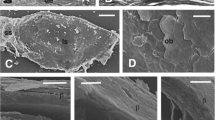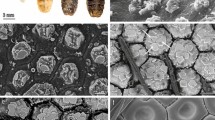Summary
Cuticle discs cut from the wings ofPeriplaneta and cuticular lipid extracts were analysed by differential scanning calorimetry. Two major endothermic events, one beginning at 7.1±0.3°C, and the other increasing with temperature above 24.7±0.7°C, were associated with extractable lipids in intact cuticle discs. Heating progressively destroyed the molecular structures responsible for the high temperature event but had no effect on the lower one. These results complement changes in cuticle permeability observed in a recent study and thought to be associated with structural change in the cuticular water barrier. The molecular structures responsible for both events depended on the presence of water in the cuticle. Cuticular lipid extracts lack the molecular organization found in intact cuticle, even when water is present.
Similar content being viewed by others
References
Beament JWL (1955) Wax secretion in the cockroach. J Exp Biol 32:514–538
Beament JWL (1958) The effect of temperature on the water-proofing mechanism of an insect. J Exp Biol 35:494–519
Beament JWL (1961) The water relations of insect cuticle. Biol Rev 36:281–320
Beament JWL (1964) The active transport and passive movement of water in insects. In: Beament JWL, Treherne JE, Wigglesworth VB (eds) Advances in insect physiology (Vol 2). Academic Press, New York and London, pp 67–129
Beament JWL (1965) The active transport of water: evidence, models and mechanisms. Symp Soc Exp Biol 19:273–298
Beament JWL (1968) Lipid layers and membrane models. In: Beament JWL, Treherne JE (eds) Insects and physiology. Elsevier, New York, pp 303–314
Cook HD, Ries HE (1959) Adsorption of radiostearic acid and radiostearyl alcohol from n-hexadecane onto solid surfaces. J Phys Chem Ithaca 63:226–230
Edney EB, McFarlane J (1974) The effect of temperature on transpiration in the desert cockroach,Arenivaga investigata and inPeriplaneta americana. Physiol Zool 47:1–12
Filshie BK (1970) The resistance of epicuticular components of an insect to extraction with lipid solvents. Tissue and Cell 2:181–190
Folch J, Lees M, Stanley GHS (1957) A simple method for the isolation and purification of total lipides from animal tissues. J Biol Chem 226:497–509
Gelman N, Machin J, Kestler P (1988) The nature of driving forces for passive water transport through arthropod cuticle. J Therm Biol 13:157–162
Gilby AR (1980) Transpiration, temperature and lipids in insect cuticle. In: Berridge MJ, Treherne JE, Wigglesworth VB (eds) Advances in insect physiology (Vol 15). Academic Press, New York, pp 1–33
Gilby AR, Cox ME (1963) The cuticular lipids of the cockroachPeriplaneta americana (L). J Insect Physiol 9:671–681
Lockey KH (1976) Cuticular hydrocarbons ofLocusta, Schistocerca andPeriplaneta, and their role in waterproofing. Insect Biochem 6:457–472
Machin J (1980) Cuticle water relations: towards a new cuticle waterproofing model. In: Locke M, Smith DS (eds) Insect biology in the future. Academic Press, New York, pp 79–103
Machin J, Lampert GJ (1989) Energetics of water diffusion through the cuticular water barrier ofPeriplaneta: the effect of temperature, revisited. J Insect Physiol 35:437–445
Machin J, Lampert GJ, O'Donnell MJ (1985) Component permeabilities and water contents inPeriplaneta integument: role of the epidermis re-examined. J Exp Biol 117:155–169
Ramsay JA (1935) The evaporation of water from the cockroach. J Exp Biol 12:373–83
Toolson EG, White TR, Glaunsinger WS (1979) Electron paramagenetic resonance spectroscopy of spin-labelled cuticle ofCentruroides sculpturatus (Scorpiones: Buthidae): correlation with thermal effects on cuticular permeability. J Insect Physiol 25:271–75
Author information
Authors and Affiliations
Rights and permissions
About this article
Cite this article
Machin, J., Lampert, G.J. Evidence for water-organized structure in the cuticular water barrier of the American cockroach,Periplaneta americana . J Comp Physiol B 159, 739–744 (1990). https://doi.org/10.1007/BF00691719
Accepted:
Issue Date:
DOI: https://doi.org/10.1007/BF00691719




